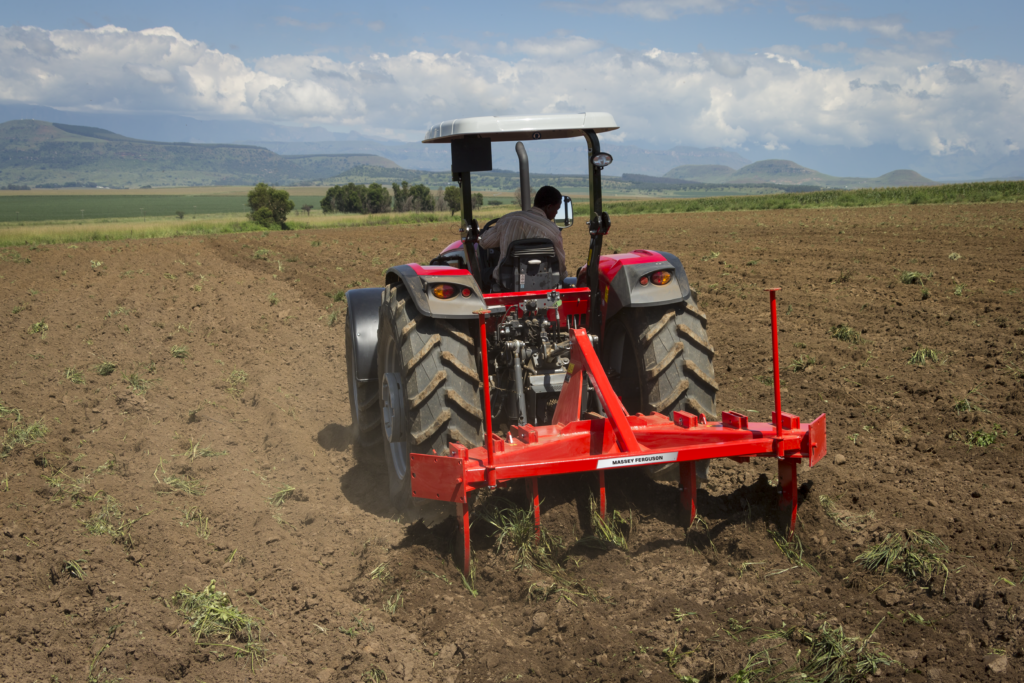FARM TIPS
ARE YOU PREPARING YOURSELF FOR A HIGH YIELDING SEASON?
Dr Benard Ngwene, Training manager for AGCO Africa, is an agricultural scientist involved in proposing mechanisation solutions for smallholders and emerging farmers. In this article, he stresses the importance of preparing soil before the summer rain.

A Massey Ferguson 35 tractor equipped with a fertiliser spreader. Good soil preparation is a major determinant of yield.
While many parts of Southern Africa endure a persistent drought that started back in October 2018, the 2019 planting season is fast approaching and farmers have to make crucial decisions on how to recover from last season’s double digit decline in crop harvests. Land preparation is where everything begins. This is the big window of opportunity for farmers to prepare for planting summer grains and oilseed. The recent forecast of improved regional rainfall and precipitation by Southern African Development Community meteorologists is certainly encouraging news for farmers. Moisture is one of the main limiting factors to crop production; farmers have to align all operations with rain patterns. Now is the time to get yourself and your farm prepared to get maximum benefit from the rains when they come.
USE THE OPPORTUNITY
This year’s planting season is expected to coincide with predicted late November showers. There should, therefore, be adequate time to apply best practice cultivation techniques to prepare the land. This starts with land clearing using mechanical or chemical (herbicide) methods, then applying adequate tillage to create an optimal seedbed.
It’s crucial to consider the farm’s soil type, moisture level and the intended crop so that you can ensure optimal soil-to-seed contact and avoid soil clods. Many farms are affected by soil compaction. This is when soil layers are compressed so that pore spaces are reduced to below optimum levels, resulting in an increase in soil density, decreased air and water movement, and reduced root growth. It is caused principally by poor tillage practices and is common in local farming systems. In addition to creating this restrictive soil layer, compaction induces waterlogging, which reduces root respiration and promotes surface run-off and hence erosion. If the soil is compacted farmers should take action.
This can include activities such as subsoiling or ripping to break the compacted layer. This will open up soil volume previously unavailable to your crops. Cultivation generally involves soil disturbance (moving the soil to a certain degree), which affects soil moisture and organic matter, which are two critical components in soil. You should therefore seek to disturb the soil as little as possible. That means minimising the extent and depth of cultivation by applying minimum tillage and cultivating the soil only where the plant is to be seeded. Less soil disturbance (ripping rather than ploughing) will conserve more moisture and soil organic matter, which is generally very low in African soils and one of the main reasons for poor productivity. Soil organic matter (dead and decaying plant or animal material, and soil organisms) improves soil structure, retains and supplies nutrients, and retains moisture. So, be as conservative as possible with your tillage.
Ploughing creates a reasonably suitable seedbed, but it has a negative effect on soil moisture and organic matter. A good quality, hard-wearing two to five tine subsoiler or ripper made of high-quality steel tines of 30mm thickness will achieve perfect deep breaking of the soil pan and a good finishing for seeding. Keep in mind that how you cultivate your soil in the short and long terms will affect moisture and nutrient availability to your plants.

ABOVE: A Massey Ferguson 4708 working with a five-tine ripper. Ripping is less destructive to the soil’s structure than ploughing .
TO CONSERVE SOIL MOISTURE AND ORGANIC MATTER, DISTURB THE SOIL AS LITTLE AS POSSIBLE
ALTERNATE YOUR CROPS
Different crops have different root systems and nutrient uptake strategies. Maize, for example, exploits nutrients from a different soil pool (reservoir) than soya beans. Therefore, alternating crops ensures better use of soil resources. Rotating crops may also help to break disease cycles, as a particular disease may not be able to survive in all crops. Crop rotation is therefore advisable, particularly if you rotate between maize and a legume such as soya beans or groundnuts. The legumes will enrich the soil with nitrogen to the benefit of the following maize crop and reduce fertiliser costs.
MORE RAIN AND HIGHER MAIZE ESTIMATES
With the rain forecast and the International Grains Council’s preliminary estimates for maize production for 2019/2020 projected to be 16% higher than the current season, Southern Africa can anticipate a positive planting season, provided farmers prepare their lands optimally and in good time while waiting for the rain.
